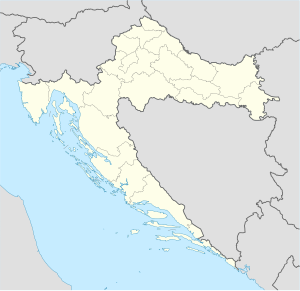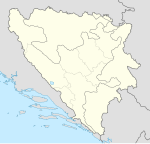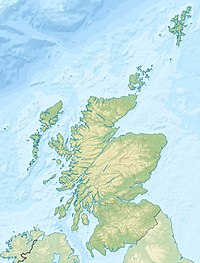模板:Location map/testcases
| 這是Template:Location map及其沙盒的測試樣例。刷新本頁以更新內容。 如果這裏有許多複雜的模板的用例,可能會因為MediaWiki的技術限制而出錯。 您還可以用Special:展開模板來測試模板的使用效果。 您可以通過以下連結測試本模板在不同外觀下的效果: |
測試 1
[編輯]{{Location map
| Oxford (central)#United Kingdom Oxford
| float = left
| coordinates = {{coord|51.762123|-1.261974|display=inline,title}}
| border = infobox
| caption =
| excludefrom = United Kingdom Oxford
}}
| {{Location map}} | {{Location map/sandbox}} |
|---|---|
測試 2
[編輯]Multimaps without an infobox
{{Location map
| UK Scotland#UK
| relief = 1
| width = 180
| float = right
| caption = Lockerbie in Scotland, UK
| alt = Lockerbie is in southern Scotland.
| label = Lockerbie
| mark = Blue_pog.svg
| marksize = 9
| lat_deg = 55 | lat_min = 07 | lat_sec = 16 | lat_dir = N
| lon_deg = 03 | lon_min = 21 | lon_sec = 19 | lon_dir = W
}}
| {{Location map}} | {{Location map/sandbox}} |
|---|---|
測試 3
[編輯]{{Location map
| Croatia
| label = Pag
| mark = <!--dot-->Green pog.svg
| lat_deg = 44
| lat_min = 26
| lon_deg = 15
| lon_min = 3
| position = right
| width = 300
| float = right
}}
| {{Location map}} | {{Location map/sandbox}} |
|---|---|
測試 4
[編輯]{{Location map
| Croatia
| label = Pag
| lat = 44.44
| long = 15.05
| position = right
| width = 200
| float = right
}}
| {{Location map}} | {{Location map/sandbox}} |
|---|---|
測試 5
[編輯]{{Location map
| Croatia
| label = Pag
| alt = Pag lies off the West coast of Croatia, in the Adriatic Sea
| mark = <!--dot-->Green pog.svg
| lat_deg = 44
| lat_min = 26
| lon_deg = 15
| lon_min = 3
| position = right
| width = 300
| float = right
}}
| {{Location map}} | {{Location map/sandbox}} |
|---|---|
測試 6
[編輯]{{Location map
| Croatia
| label = Imotski
| lat = 43.44
| long = 17.21
| position = right
| width = 300
| float = right
| background = #FFFFDD
| caption = Imotski on the map of Croatia
}}
| {{Location map}} | {{Location map/sandbox}} |
|---|---|
測試 7
[編輯]{{Location map
| Croatia
| label = Pag
| label_size = 200
| lat = 44.44
| long = 15.05
| position = right
| width = 300
| float = right
| background = #FFFFDD
| caption = Pag Island on the map of Croatia
}}
| {{Location map}} | {{Location map/sandbox}} |
|---|---|
測試 8
[編輯]{{Location map
| Bosnia
| label = Brčko
| position = left
| width = 150
| lat = 44.87
| long = 18.81
| float = right
| caption =
}}
| {{Location map}} | {{Location map/sandbox}} |
|---|---|
測試 9
[編輯]{{Location map
| Ghana
| label = Tema
| coordinates = {{coord|05|40|N|00|00|W}}
| width = 150
| float = right
}}
| {{Location map}} | {{Location map/sandbox}} |
|---|---|
測試 10
[編輯]{{Location map
| UK Scotland
| label = Lockerbie
| marksize = 9
| mark = Blue_pog.svg
| lat_dir = N
| lat_deg = 55
| lat_min = 7
| lat_sec = 16
| lon_dir = W
| lon_deg = 3
| lon_min = 21
| lon_sec = 19
| position = right
| width = 170
| float = right
| caption = Lockerbie in Scotland
}}
| {{Location map}} | {{Location map/sandbox}} |
|---|---|
測試 11
[編輯]{{Location map
| UK Scotland
| lat_deg = 55 | lat_min = 07 | lat_sec = 16 | lat_dir = N
| lon_deg = 03 | lon_min = 21 | lon_sec = 19 | lon_dir = W
| label = Lockerbie
| position = right
| mark = Blue_pog.svg
| marksize = 9
| width = 200
| relief = yes
| float = right
| caption = Lockerbie in Scotland
| alt = Lockerbie is in southern Scotland.
}}
| {{Location map}} | {{Location map/sandbox}} |
|---|---|
測試 12
[編輯]{{Location map
| Russia
| label = Uelen
| marksize = 7
| mark = Locator_Dot.png
| lat_deg = 66
| lat_min = 09
| lat_dir = N
| lon_deg = 169
| lon_min = 48
| lon_dir = W
| position = left
| width = 500
| float = left
| background = yellow
}}
| {{Location map}} | {{Location map/sandbox}} |
|---|---|
測試 13
[編輯]{{Location map
| Russia
| label = Uelen
| marksize = 7
| mark = Locator_Dot.png
| lat_deg = 66
| lat_min = 09
| lat_dir = N
| lon_deg = 169
| lon_min = 48
| lon_dir = W
| position = left
| width = 500
| float = left
| background = yellow
| max_width = 300
}}
| {{Location map}} | {{Location map/sandbox}} |
|---|---|
測試 14
[編輯]Float left
[編輯]Walraversijde was discovered on the Belgian coast by the archeologist Marnix Pieters in 1992 in a dune area, near a medieval dyke. Prior to discovery, Walraversijde was a lost village, with no obvious remains above ground. Two related sites were excavated, one on a beach and the other on a polder. The beach site was inhabited between 1200 and 1400, and the polder site was inhabited between 1400 and 1630. The excavations also found evidence of activities during the Roman era, such as a Roman dyke.
Walraversijde played a role during the Siege of Ostend of 1601-1604, when a Spanish cavalry camp operated from the site. The artefacts and remains are well preserved, and there have been many finds. The sites have been excavated systematically and thoroughly, and have produced unusually rich findings.
Image thumb float left

Walraversijde was discovered on the Belgian coast by the archeologist Marnix Pieters in 1992 in a dune area, near a medieval dyke. Prior to discovery, Walraversijde was a lost village, with no obvious remains above ground. Two related sites were excavated, one on a beach and the other on a polder. The beach site was inhabited between 1200 and 1400, and the polder site was inhabited between 1400 and 1630. The excavations also found evidence of activities during the Roman era, such as a Roman dyke.
Walraversijde played a role during the Siege of Ostend of 1601-1604, when a Spanish cavalry camp operated from the site. The artefacts and remains are well preserved, and there have been many finds. The sites have been excavated systematically and thoroughly, and have produced unusually rich findings.
Float center
[編輯]Walraversijde was discovered on the Belgian coast by the archeologist Marnix Pieters in 1992 in a dune area, near a medieval dyke. Prior to discovery, Walraversijde was a lost village, with no obvious remains above ground. Two related sites were excavated, one on a beach and the other on a polder. The beach site was inhabited between 1200 and 1400, and the polder site was inhabited between 1400 and 1630. The excavations also found evidence of activities during the Roman era, such as a Roman dyke.
Walraversijde played a role during the Siege of Ostend of 1601-1604, when a Spanish cavalry camp operated from the site. The artefacts and remains are well preserved, and there have been many finds. The sites have been excavated systematically and thoroughly, and have produced unusually rich findings.
Image thumb float center

Walraversijde was discovered on the Belgian coast by the archeologist Marnix Pieters in 1992 in a dune area, near a medieval dyke. Prior to discovery, Walraversijde was a lost village, with no obvious remains above ground. Two related sites were excavated, one on a beach and the other on a polder. The beach site was inhabited between 1200 and 1400, and the polder site was inhabited between 1400 and 1630. The excavations also found evidence of activities during the Roman era, such as a Roman dyke.
Walraversijde played a role during the Siege of Ostend of 1601-1604, when a Spanish cavalry camp operated from the site. The artefacts and remains are well preserved, and there have been many finds. The sites have been excavated systematically and thoroughly, and have produced unusually rich findings.
Float right
[編輯]Walraversijde was discovered on the Belgian coast by the archeologist Marnix Pieters in 1992 in a dune area, near a medieval dyke. Prior to discovery, Walraversijde was a lost village, with no obvious remains above ground. Two related sites were excavated, one on a beach and the other on a polder. The beach site was inhabited between 1200 and 1400, and the polder site was inhabited between 1400 and 1630. The excavations also found evidence of activities during the Roman era, such as a Roman dyke.
Walraversijde played a role during the Siege of Ostend of 1601-1604, when a Spanish cavalry camp operated from the site. The artefacts and remains are well preserved, and there have been many finds. The sites have been excavated systematically and thoroughly, and have produced unusually rich findings.
Image thumb float right

Walraversijde was discovered on the Belgian coast by the archeologist Marnix Pieters in 1992 in a dune area, near a medieval dyke. Prior to discovery, Walraversijde was a lost village, with no obvious remains above ground. Two related sites were excavated, one on a beach and the other on a polder. The beach site was inhabited between 1200 and 1400, and the polder site was inhabited between 1400 and 1630. The excavations also found evidence of activities during the Roman era, such as a Roman dyke.
Walraversijde played a role during the Siege of Ostend of 1601-1604, when a Spanish cavalry camp operated from the site. The artefacts and remains are well preserved, and there have been many finds. The sites have been excavated systematically and thoroughly, and have produced unusually rich findings.
測試 15
[編輯]{{Location map/sandbox}}
[編輯]- left
- right
- none
- default
{{Location map}}
[編輯]- left
- right
- none
- default
測試 16
[編輯]{{Location map
| Crimea#Ukraine#European Russia#Europe
| caption = Location of Yalta within Crimea##Location of Yalta within Ukraine##Location of Yalta within Russia##Location of Yalta within Europe
| coordinates = {{coord|44|29|58|N|34|10|12|E|region:UA|display=inline,title}}
| label = 雅尔塔
}}
| {{Location map}} | {{Location map/sandbox}} |
|---|---|


















